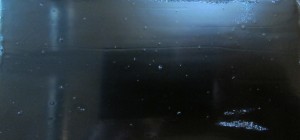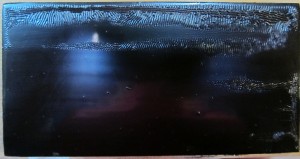For my research I want to compare the working properties and long term aging characteristics of three types of urushi, transparent urushi processed in Japan from Chinese urushi, Black Roiro urushi processed in Japan from Chinese urushi, Black Roiro of Japanese urushi.
One of the well known difficulties in the application of the finishing coats is the prospect of dust particles marring the coating. There are many recommendations for avoiding this, including the ancient tale of performing urushi coating in a boat on a lake at night when there is the least dust in the air. Although I am on the ocean here in Halfmoon Bay moving the entire operation to a boat was not going to happen. Instead I embarked on massive lab clean up, tidying, dusting, vacuuming, and washing the floor.
Other sources of dust are the urushi itself, the brushes and the object. For this I filtered the urushi with paper especially made for this purpose. A suitable amount of urushi, about a teaspoon for my purpose, was placed on the paper. The paper was then folded over and then twisted until the urushi was squeezed out into a clean glass bowl. This does remove any particles that may be found in the urushi, however it also added air bubbles. Prior to application the brush must be cleaned. I was using an urushi brush that I purchased in Japan and had last used several years ago. The brushes are stored with a non-drying oil(often rape seed ) on the bristles so any remaining urushi after the last use and cleaning will not dry. The oil must be removed with solvent. This means several application of solvent and the use of a bone spatula to work through the bristles to ensure all the oil is removed. To test if there is still oil on the brush, solvent is drawn out on across the ceramic surface, allowed to evaporate so one can observe if there is any oil remaining. Next step is to work the urushi into the brush and test the result on the ceramic again. Once the urushi flows out evenly without dust the brush is ready to be used. Finally just before application the board was given one final wipe with solvent and allowed to evaporate before painting out the urushi with a smooth even strike.
I began with the black urushi processed in Japan from Chinese urushi. With all these measures I did not have a problem with dust particles but a multitude of bubbles instead. I tried to remove them by brushing them out but every brush stroke brought an increase in the number of bubbles. After application of the urushi the panel is set aside to allow the brush strokes to level out so I had hoped that they would break. In this case some of the bubbles disappeared but most remained. I noticed that there were fewer bubbles if the urushi was applied fairly thickly. Unfortunately this was not the answer. Wrinkles were the result on drying.
So there I was with six boards covered in bubbles and wrinkles. I sent out a call for help. Stay tuned for the next episode.
If any of you have suggestions I certainly would like to hear from you.


